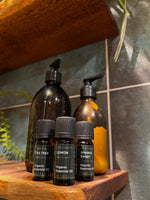
Organic Essential Oils 10ml
£9.60 GBP
Unit price perEstimated delivery between December 30 and January 02.
In stock - Ready to be shipped
Orange Sweet Essential Oil
Orange Sweet oil is a member of the Rutaceae family. This oil has a sweet, fresh-fruity scent and is classed as a top note. It blends beautifully with camphoraceous, citrus, herby, floral, minty, spicy, and woodsy oils.
Orange is valued for its antidepressant, anti-inflammatory, antiseptic, and bactericidal properties. Its uplifting aroma makes it ideal for cleaning, mood enhancement, and cosmetic applications.
Botanical Name: Citrus sinensis
Origin: Mexico
Family: Rutaceae
Plant Part: Peels
Extraction: Cold Pressed
Note: Top
Colour: Orange
Consistency: Light
Scent: Sweet citrus, like concentrated orange peel
Blends With: Camphoraceous, citrus, floral, herby, minty, spicy, and woodsy oils
Group: Citrus
Usage: Essential oils can be applied topically once diluted with a carrier oil. Never use pure oils on the skin without diluting, never ingest, keep away from children and eyes, and always check for medical issues that may cause a problem. Seek professional advice if unsure.
Lavandin Grosso Essential Oil
Lavandin Grosso oil is a member of the Lamiaceae family. It has a fresh camphoraceous top note with a woody, herbaceous undertone and is classed as a middle note. It blends well with citrus, floral, spicy, and woodsy oils.
Lavandin Grosso is packed with antiseptic, anti-fungal, antimicrobial, and antioxidant properties, making it a versatile essential oil. Its scent is known to calm, relieve stress, and encourage restful sleep.
Botanical Name: Lavandula hybrida
Origin: France
Family: Lamiaceae
Plant Part: Flowers
Extraction: Steam Distillation
Note: Middle
Colour: Pale yellow liquid
Consistency: Thin
Scent: Strong, camphor-like with light floral undertones
Blends With: Citrus, floral, spicy, and woodsy oils
Group: Floral
Usage: Essential oils can be applied topically once diluted with a carrier oil. Never use pure oils on the skin without diluting, never ingest, keep away from children and eyes, and always check for medical issues that may cause a problem. Seek professional advice if unsure.
Eucalyptus Smithii Essential Oil
Eucalyptus Smithii oil is a member of the Myrtaceae family. It has a somewhat harsh, medicinal odour with a woody-sweet undertone and is classed as a top-middle note. It blends well with camphoraceous, citrus, and woodsy oils.
Eucalyptus is highly valued for its analgesic, antiseptic, antiviral, and decongestant properties. It supports respiratory and immune health and also works as an excellent insect repellent.
Botanical Name: Eucalyptus smithii
Origin: Australia
Family: Myrtaceae
Plant Part: Leaves
Extraction: Steam Distillation
Note: Middle
Colour: Colourless to pale yellow
Consistency: Thin
Scent: Sweet, fruity-lemon fragrance with rosemary-like undertones
Blends With: Camphoraceous, citrus, and woodsy oils
Group: Camphoraceous
Usage: Essential oils can be applied topically once diluted with a carrier oil. Never use pure oils on the skin without diluting, never ingest, keep away from children and eyes, and always check for medical issues that may cause a problem. Seek professional advice if unsure.
Lemon Essential Oil
Lemon oil is a member of the Rutaceae family. It has a sharp, fresh scent and is classed as a top note. It blends well with camphoraceous, citrus, herby, floral, minty, spicy, and woodsy oils.
Lemon is known for its purification, antibacterial, and anti-fungal properties, making it excellent for cleaning purposes. It can also help relieve nausea, improve digestion, and nourish the skin.
Botanical Name: Citrus limon
Origin: Italy
Family: Rutaceae
Plant Part: Peel of the fruit
Extraction: Cold Pressed
Note: Top
Colour: Light yellow
Consistency: Thin
Scent: Fresh lemon rind, rich and concentrated
Blends With: Camphoraceous, citrus, floral, herby, minty, spicy, and woodsy oils
Group: Citrus
Usage: Essential oils can be applied topically once diluted with a carrier oil. Never use pure oils on the skin without diluting, never ingest, keep away from children and eyes, and always check for medical issues that may cause a problem. Seek professional advice if unsure.
Tea Tree
Tea Tree oil is a member of the Myrtaceae family. This oil has a fresh, herbaceous, and medicinal aroma and is classed as a middle note. It blends beautifully with camphoraceous, citrus, and woodsy oils.
Tea Tree is celebrated for its anti-inflammatory, antibacterial, antiseptic, and antimicrobial properties. Its powerful cleansing abilities make it a staple in skincare, especially for treating acne and soothing irritated skin. Tea Tree also supports immune health and is a natural choice for cleaning and purification.
Botanical Name: Melaleuca alternifolia
Origin: South Africa
Family: Myrtaceae
Plant Part: Leaves
Extraction: Steam Distillation
Note: Middle
Colour: Pale yellow to colourless
Consistency: Thin
Scent: Fresh, antiseptic, and medicinal with subtle mint and spice undertones
Blends With: Camphoraceous, citrus, and woodsy oils
Group: Camphoraceous
Usage: Essential oils can be applied topically once diluted with a carrier oil. Never use pure oils on the skin without diluting, never ingest, keep away from children and eyes, and always check for medical issues that may cause a problem. Seek professional advice if unsure.
Share









